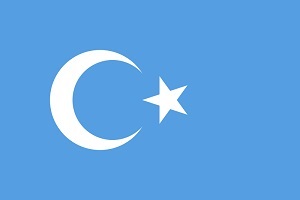East Turkestan: Difference between revisions
John Leach (talk | contribs) m (Text replacement - "Uyghur" to "Uighur") |
John Leach (talk | contribs) m (Text replacement - "East Turkestan Independence Movement" to "East Turkestan Independence Movement") |
||
| Line 5: | Line 5: | ||
The 'greater' Turkestan was subdivided into West (former [[Soviet Union]] countries) and East Turkestan (administered as the Xinjiang Uighur Autonomous Region by the [[People's Republic of China]]). The Tian Shan (Tengri Tagh) and Pamir mountain ranges form the rough division between the two Turkestans. East Turkestan (Modern Xinjiang Uighur Autonomous Region) contains a number of ancient historical cities of Turkic culture, notably Kashgar, Hotan, Turfan, Yarkand, Ili (Ghulja), Kumul, Aqsu, Kucha, and Altay. | The 'greater' Turkestan was subdivided into West (former [[Soviet Union]] countries) and East Turkestan (administered as the Xinjiang Uighur Autonomous Region by the [[People's Republic of China]]). The Tian Shan (Tengri Tagh) and Pamir mountain ranges form the rough division between the two Turkestans. East Turkestan (Modern Xinjiang Uighur Autonomous Region) contains a number of ancient historical cities of Turkic culture, notably Kashgar, Hotan, Turfan, Yarkand, Ili (Ghulja), Kumul, Aqsu, Kucha, and Altay. | ||
An independent Republic of East Turkestan briefly existed prior to the invasion and assumption of control of the area by the [[People's Liberation Army]] in 1949. In recent years, the region has experienced violently suppressed anti-government demonstrations and an active separatist | An independent Republic of East Turkestan briefly existed prior to the invasion and assumption of control of the area by the [[People's Liberation Army]] in 1949. In recent years, the region has experienced violently suppressed anti-government demonstrations and an active separatist East Turkestan Independence Movement, which the Chinese administration has classified as a terrorist organization. | ||
Revision as of 15:46, 1 April 2024
East Turkestan (also transliterated: East Turkistan; Uighur: شەرقىي تۈركىستان Sherqiy Türkistan), also known as Uighuristan, is the part of greater Turkestan in Xinjiang, China and far eastern Central Asia. The area is largely inhabited by indigenous Turkic peoples, with an increasing emigrant Han minority. Famed merchant and explorer Marco Polo crossed Turkestan in the year 1272 CE.
The 'greater' Turkestan was subdivided into West (former Soviet Union countries) and East Turkestan (administered as the Xinjiang Uighur Autonomous Region by the People's Republic of China). The Tian Shan (Tengri Tagh) and Pamir mountain ranges form the rough division between the two Turkestans. East Turkestan (Modern Xinjiang Uighur Autonomous Region) contains a number of ancient historical cities of Turkic culture, notably Kashgar, Hotan, Turfan, Yarkand, Ili (Ghulja), Kumul, Aqsu, Kucha, and Altay.
An independent Republic of East Turkestan briefly existed prior to the invasion and assumption of control of the area by the People's Liberation Army in 1949. In recent years, the region has experienced violently suppressed anti-government demonstrations and an active separatist East Turkestan Independence Movement, which the Chinese administration has classified as a terrorist organization.
